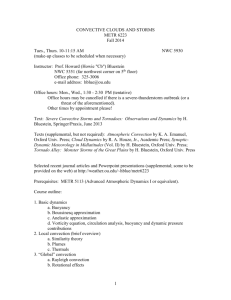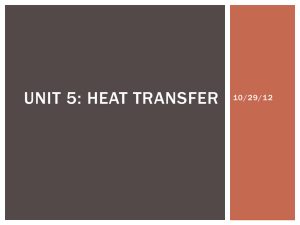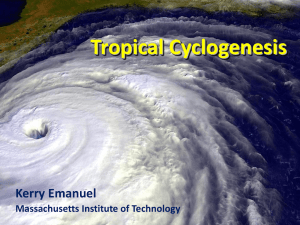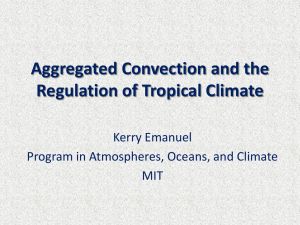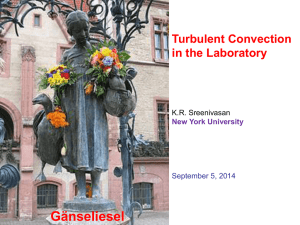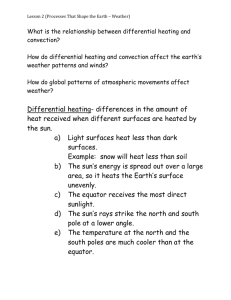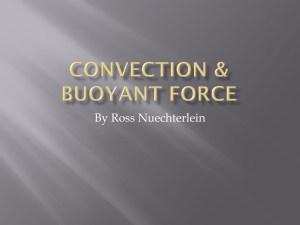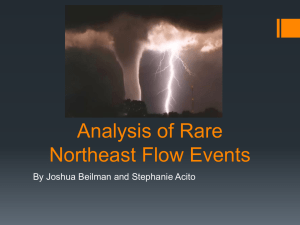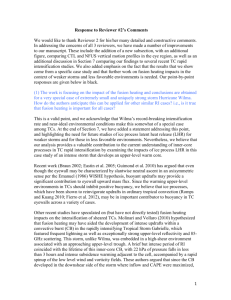Editor_response_22Jun
advertisement
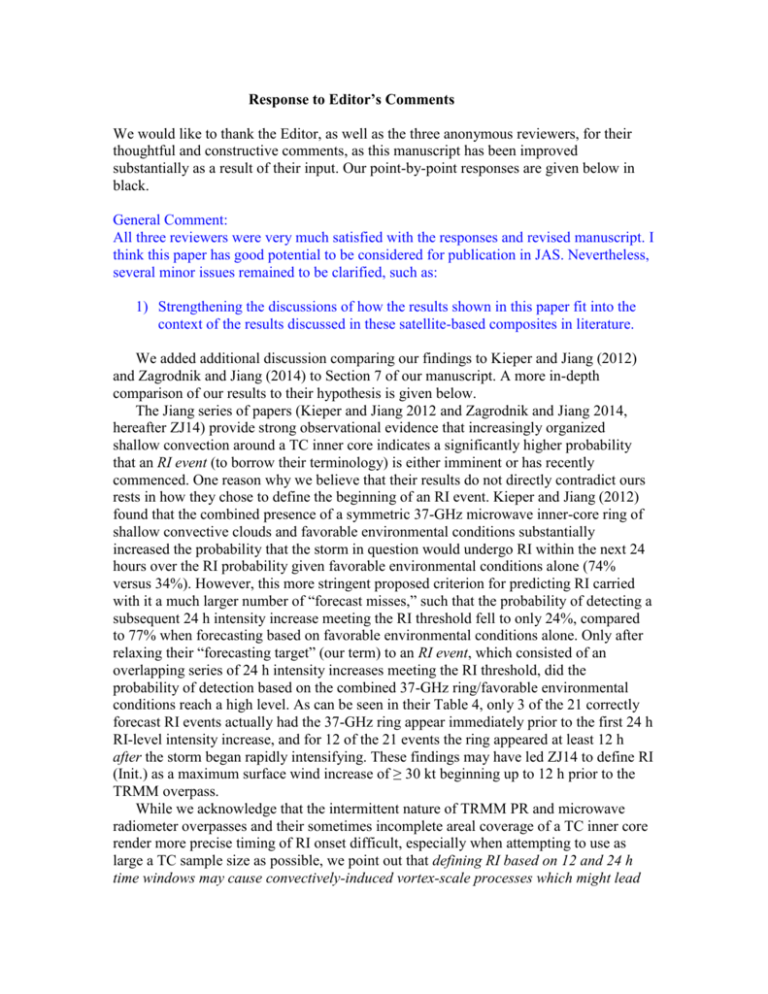
Response to Editor’s Comments We would like to thank the Editor, as well as the three anonymous reviewers, for their thoughtful and constructive comments, as this manuscript has been improved substantially as a result of their input. Our point-by-point responses are given below in black. General Comment: All three reviewers were very much satisfied with the responses and revised manuscript. I think this paper has good potential to be considered for publication in JAS. Nevertheless, several minor issues remained to be clarified, such as: 1) Strengthening the discussions of how the results shown in this paper fit into the context of the results discussed in these satellite-based composites in literature. We added additional discussion comparing our findings to Kieper and Jiang (2012) and Zagrodnik and Jiang (2014) to Section 7 of our manuscript. A more in-depth comparison of our results to their hypothesis is given below. The Jiang series of papers (Kieper and Jiang 2012 and Zagrodnik and Jiang 2014, hereafter ZJ14) provide strong observational evidence that increasingly organized shallow convection around a TC inner core indicates a significantly higher probability that an RI event (to borrow their terminology) is either imminent or has recently commenced. One reason why we believe that their results do not directly contradict ours rests in how they chose to define the beginning of an RI event. Kieper and Jiang (2012) found that the combined presence of a symmetric 37-GHz microwave inner-core ring of shallow convective clouds and favorable environmental conditions substantially increased the probability that the storm in question would undergo RI within the next 24 hours over the RI probability given favorable environmental conditions alone (74% versus 34%). However, this more stringent proposed criterion for predicting RI carried with it a much larger number of “forecast misses,” such that the probability of detecting a subsequent 24 h intensity increase meeting the RI threshold fell to only 24%, compared to 77% when forecasting based on favorable environmental conditions alone. Only after relaxing their “forecasting target” (our term) to an RI event, which consisted of an overlapping series of 24 h intensity increases meeting the RI threshold, did the probability of detection based on the combined 37-GHz ring/favorable environmental conditions reach a high level. As can be seen in their Table 4, only 3 of the 21 correctly forecast RI events actually had the 37-GHz ring appear immediately prior to the first 24 h RI-level intensity increase, and for 12 of the 21 events the ring appeared at least 12 h after the storm began rapidly intensifying. These findings may have led ZJ14 to define RI (Init.) as a maximum surface wind increase of ≥ 30 kt beginning up to 12 h prior to the TRMM overpass. While we acknowledge that the intermittent nature of TRMM PR and microwave radiometer overpasses and their sometimes incomplete areal coverage of a TC inner core render more precise timing of RI onset difficult, especially when attempting to use as large a TC sample size as possible, we point out that defining RI based on 12 and 24 h time windows may cause convectively-induced vortex-scale processes which might lead to enhanced coverage of inner-core shallow convection to be missed. For their Hurricane Dennis (2005) modeling study, McFarquhar et al. (2012) chose to define RI onset based on peak intensification rates over shorter (3 and 6 h) timescales, which they believed might be more closely tied to vortex-scale processes, rather than to environmental conditions. Observations have shown that pulses of CB activity preceding substantial TC intensification last for periods on the order of several hours or less (Heymsfield et al. 2001; Guimond et al. 2010). Jiang et al. (2001), in describing the construction of the TRMM PR dataset used in ZJ14, provides no information regarding the TC sampling frequency statistics, but it appears, based on the fact that only 2315 of the total 13,677 TRMM PR overpasses were centered within 100 km of the best-track interpolated TC center and because ZJ14 only included data where “at least some portion of the TC center or near-center area is within the PR swath,” that transient spikes in CB activity could be easily missed by this dataset. In their Section 4, ZJ14 discussed how a shallow convective ring developing around time of RI onset could render the inner-core environment more favorable to deep convection through increased low-level convergence and low-to-middle tropospheric relative humidity. Although the ZJ14 dataset only included TCs embedded in environmental conditions reasonably conducive to RI, it could also be argued that for TCs travelling over very high SSTs (≥ 29° C), roughly 25% of their total sample (see ZJ14 Fig. 1a), transient inner core CB outbreaks could be more prevalent, regardless of whether a shallow convective ring is already present. Hurricanes Wilma (2005) and Dennis (2005) are examples of such storms (Rogers 2010; Chen et al. 2011). Chen and Zhang (2013) found that reducing the SSTs by 1° C substantially reduced Wilma’s innercore CB activity. Although ZJ14 showed, using large TC sample composites, how RI onset tended to be associated with an expansion of shallow convection upshear from the favored downshear-left quadrant, they acknowledged that their study fell short of fully explaining the processes leading to the expansion of the shallow convective coverage. We argue that an increase in weak-to-moderate convection surrounding the eye could simply be a manifestation of an intensifying axisymmetric background secondary circulation, a process that might ultimately be caused by outbreaks of inner-core deep convection. This might be achieved through 1) latent heating in the developing eyewall that forces the development of a transverse circulation under the constraints of axisymmetric balanced dynamics (Shapiro and Willoughby 1982), 2) a transient increase in midlevel updraft mass flux concentrated within the radius of maximum wind where latent heating is more efficiently converted to kinetic energy (Rogers 2010), and/or 3) by the vortex response to surface pressure falls generated by the CB-induced subsidence warming in the eye (Chen and Zhang 2013; Heymsfield et al. 2001; Guimond et al. 2010). Recently, Rogers et al. (2013) showed, using a large observational dataset, that the inner-core regions of intensifying TCs (maximum surface wind increase ≥ 20 kt) were characterized both by enhanced deep convection and by more extensive lower-reflectivity echoes. The key question is: do what extent do these processes feed back upon each other as the vortex evolves, and does one process ultimately “cause” the other? Future highresolution modeling and observational case studies focusing on convective and vortexscale processes in the 12-24 h period leading up to RI onset may help clarify this problem. Comparing cases with moderately favorable environmental conditions for RI (i.e. SSTs 26-28° C, vertical wind shear magnitude 5-10 kt) to those with highly favorable surroundings (i.e. SSTs ≥ 29° C, vertical wind shear magnitude < 5 kt) might also help definitively answer the question of whether the importance of deep convection to RI depends to any extent on a storm’s surroundings. While we disagree with the Jiang studies on the relative importance of shallow versus weak convection in causing RI, we believe that they provide an important contribution to the field, particularly from an operational TC forecasting standpoint. As ZJ14 correctly point out, shallow convection captures the full lifecycle from growth to decay of tropical precipitating clouds, allowing itself to be more easily detected by intermittent satellite overpasses than sporadic deep convective episodes. Furthermore, Kieper and Jiang (2012) showed how shallow convective rings were excellent predictors of the most rapid intensification rates, even though their appearance might lag RI onset. 2) the need to conduct a few more experiments to show more robust conclusions Note first that we have mentioned in Part I of this series of papers: “We found in our initial experimentation that the following model options are important for the reasonable prediction of the record-breaking intensity and RI rates of Wilma as well as the associated inner-core structures: (i) the finest 1-km horizontal resolution; (ii) the high (55-level) vertical resolution, especially in both the lower and upper troposphere; and (iii) a cloud-permitting microphysics scheme.” We have also tested a number of microphysics schemes when generating the CTL simulation, and found that the Thompson scheme most accurately reproduced the vortex structure with respect to the observations. Although we understand your point of conducting more experiments, it is not our intention to optimize a cloud resolving scheme, as would be done for improving an operational model, but rather to examine the impact of one physical processes. We agree that starting the simulation 6 h earlier or later could affect the intensity simulations, because data assimilation is not invoked for this study. But this should not impact the validity of our conclusions. 3) adding a few important figures shown in the responses We have added a new subsection to the manuscript (within Section 5) describing our heat budget analysis. Figure C from Response to Reviewer 3 is now included in the manuscript, listed as Figure 10. We realize that this figure provides an important contribution to our argument that the upper-level warming above the eye results primarily from adiabatic subsidence, a finding which was previously reported in some simulations of idealized TCs (Stern and Zhang 2013, Ohno and Satoh 2015). References: Chen, H., D.-L. Zhang, J. Carton, and R. Atlas, 2011: On the rapid intensification of Hurricane Wilma (2005). Part I: Model prediction and structural changes. Wea. Forecasting, 26, 885-901. , and , 2013: On the Rapid Intensification of Hurricane Wilma (2005). Part II: Convective bursts and the upper-level warm core. J. Atmos. Sci., 70, 146-162. Guimond, S. R., G. M. Heymsfield, and F. J. Turk, 2010: Multiscale observations of Hurricane Dennis (2005): The effects of hot towers on rapid intensification. J. Atmos. Sci., 67, 633-654. Heymsfield, G. M., J. B. Halverson, J. Simpson, L. Tian, and T. P. Bui, 2001: ER-2 Doppler radar investigations of the eyewall of Hurricane Bonnie during the Convection and Moisture Experiment-3. J. Appl. Meteor., 40, 1310-1330. Jiang, H., C. Liu, and E. J. Zipser, 2011: A TRMM-based tropical cyclone cloud and precipitation feature database. J. Appl. Meteor. Climatol., 50, 1255-1274. Kieper, M., and H. Jiang, 2012: Predicting tropical cyclone rapid intensification using the 37 GHz ring pattern identified from passive microwave instruments. Geophys. Res. Lett., 39, L13804: doi:10.1029/2012GL052115. McFarquhar, G. M., B. F. Jewett, M. S. Gilmore, S. W. Nesbitt, and T.-L. Hsieh, 2012: Vertical velocity and microphysical distributions related to rapid intensification in a simulation of Hurricane Dennis (2005). J. Atmos. Sci., 69, 3515-3534. Ohno, T., and M. Satoh, 2015: On the warm core of a tropical cyclone formed near the tropopause. J. Atmos. Sci., 72, 551-571. Rogers, R., 2010: Convective-scale structure and evolution during a high-resolution simulation of tropical cyclone rapid intensification. J. Atmos. Sci., 67, 44-70. , P. Reasor, and S. Lorsolo, 2013: Airborne Doppler observations of the inner-core structural differences between intensifying and steady-state tropical cyclones. Mon. Wea. Rev., 141, 2970-2991. Stern, D. P., and F. Zhang, 2013: How does the eye warm? Part I: A potential temperature budget analysis of an idealized tropical cyclone. J. Atmos. Sci., 70, 7390. Zagrodnik, J. P., and H. Jiang, 2014: Rainfall, convection, and latent heating distributions in rapidly intensifying tropical cyclones. J. Atmos. Sci., 71, 2789-2809.
